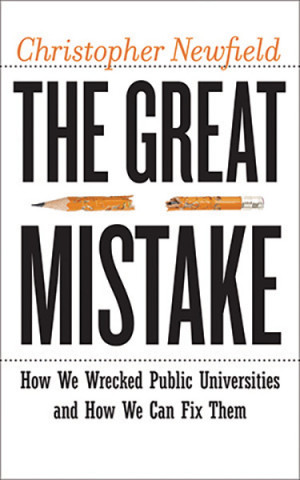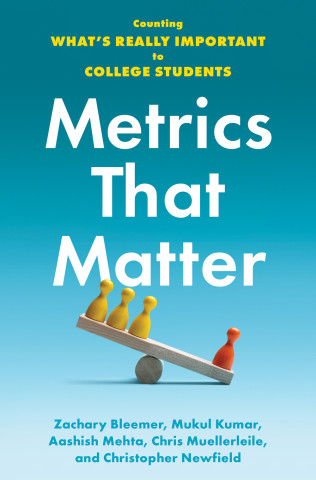How are we doing with the private-goods model? Advocates have defended it by saying that "multiple revenue streams"--tuition, philanthropy, non-resident enrollment growth, housing, for-profit masters programs--protect the university's public benefits.
I got an up-close look during my second visit this year to the University of Michigan at Ann Arbor. Preparing a lecture on the theme of "U-M: 2117," I went through the university's most recent public data, realizing I was doing this for the first time since our UC Academic Senate group wrote the "Futures Report" ten years ago, using Michigan as a worst-case state cuts scenario.
The good news is of course that U-M is one of the world's great universities, having pioneered inclusive quality and public funding in the 19th century, and gone on from there. It has wonderful people and programs, as I experienced once again first hand.
It's also a best-case example of privatization. It has an endowment of around $11 billion, making it 9th in the country and the largest public university endowment focused mainly on a single campus. It is said to have the largest living alumni base. It is second in the country in extramural grant revenues, and would be first if we excluded Johns Hopkins' Applied Physics Laboratory as a de facto government lab. It has an extraordinary number of departments ranked in their discipline's top 10 for research. It was an early entrant in professional education, and pioneered large research centers in the social sciences. It's a member of that tiny elite that doesn't lose money on its sports programs.
But there are costs.
First, students: In-state fees are $15,000 for lower division and $17,000 for upper division. Non-resident tuition is now over $50,000 for upper division students. Average student debt for borrowers is a comparatively low $26,000. But here's what the student body looks like.
Nearly two-thirds of U-M students come from families that make over $150,000 a year (top 12 percent). The students who come from the bottom half of the population by income--and who are the furthest behind the upper-middle class in college attainment--amount to 13% of the student body. U-M's Pell grant share is 15 percent, tied with the boutique private Rice University, and nearly the same as Northwestern, Tulane, and Duke. (UCSB's is 38 percent; UC Berkeley's is 31 percent, or twice Michigan's share.)
Another group whose college completion is an urgent public good are first-generation students.
Seriously, 5 percent? That's about one-third the rate of elite privates like Stanford and Princeton. U-M-Ann Arbor enrolls African-American students at around a third their share of the state's population. The data show that under the Michigan Model, the public research university simply stops being relevant to the majority of the population the system was invented to help.
In 2016, the national press discovered the feasibility of free college. In 2017, they've discovered a consequence of its absence: tuition strategies increase inequality. Some of this year's reporting is based on research from the Raj Chetty crew: a parial list of papers is here; a series of New York Times reports this year can be sampled here and here. There was renewed coverage last week from Lee Gardner at the Chronicle of Higher Education and Rick Seltzer at Inside Higher Ed, both on the theme of public universities now catering to wealthy students. The University of Michigan is Exhibit A.
What about the business end? The main private revenues are various kinds of tuition. Leaving aside their negative social effects, they are probably close to their maximum. Enrollment growth--especially non-resident enrollment growth--also has costs and limits. There may be a bit more mileage left in both, but these are mature strategies.
There's philanthropy. U-M Ann Arbor is a best-case situation.
Operating revenues from endowment are a small fraction of the U-M system's nearly $7 billion overall revenues.
Tech transfer revenues also come up in this context: UCLA recently added a business board to its operation because the professional campus staff was supposedly missing some big money. The U-M case says there isn't any.
These are gross revenues, so the return to research is much smaller. And the gross, averaged up to $25 million a year, is under 2 percent of research expenditures, never mind the overall campus budget. We need more STEM research, not less. But we can't justify it in financial terms.
The big research gross tells an important story.
Ten years ago, U-M was spending 15 cents of its own money to support each dollar of research expenditure. Now they're spending more than twice that. In 2016, they spent $456 million of their own funds on research. Inadequate cost coverage turns research universities into subsidy platforms for outside sponsors, and U-M has stayed on top by paying out of pocket (federal revenues are flat). The further universities move from public to private sponsors, the more their institutional subsidies rise. This is an absurdly taboo subject, while in the background subsidies continues to erode public university solvency.
Top university officials often say privatization, under its quasi-official name "multiple revenue streams," works just fine. The evidence says the opposite: it damages public benefits (quality degrees across the whole society), and university finances at the same time.
Two
7 hours ago










4 comments:
A big difference between UC and the U of Michigan is that the latter's arrangement was negotiated through the political process, i.e., there was an accord involved. UC just moved by fits and starts as state support dropped, and without a political go-ahead, into its current policy. The only political deal was within the Committee of Two, and that was largely after-the-fact. The legislature wasn't involved. Interest groups were not involved. In fact, no one was involved except the governor and the UC prez. -Dan Mitchell
good point. I don't like a publicly negotiated decline in public funding much better than a private deal for the same thing. And I doubt either U-M or the state officials fully grasped--given the denial that has long surrounded this issue-- that their flagship, though it has had a large non-resident share of students since the 19th century, would almost disappear from direct involvement in educating non-advantaged state residents.
Among some of the off-blog comments on this post, I got this one from a current U-M grad:
"Hi Chris, I read your post on Michigan, i absolutely agree. I've GSI'd most semesters [here], and your article discusses the aggregate issues I see in class every week. There is another thing you need to consider about the privatization of campus. The wealthy students are conditioned for success and they are well tuned to follow the pathways to success as soon as they turn up on campus, whereas the handful of first gen or lower income students look totally lost at sea. [Arriving at] Michigan, where the opportunities are overwhelming, and unable to navigate the Alpha culture of success, they end up isolated. So even for the few that have the opportunity to come from lower income homes, they rarely benefit from the plethora of opportunities.
It’s worth an ethnographic study or two.
Don't get me wrong, I love Michigan - I plan to stay here as long as i can. I'm convinced in 10 years it will be on par with the middle ivies in attracting the "better" students, however, I just see the same type of student every semester. Neoliberal automatons, conditioned to do and not to think creatively. Now this could be just a symptom of the courses i instruct... but suspect not.
In the future you’ll see out of state students increase, you’ll see that 79 per cent of 150k parental income increase. And one huge factor that will attract richer students is the harbaugh factor ... or team Michigan... I’m running to class now but each semester I see more and more 'sophisticated freshmen.'"
It's a feature, not a bug.
Socialize costs, privatize profits.
Join the Conversation
Note: Firefox is occasionally incompatible with our comments section. We apologize for the inconvenience.